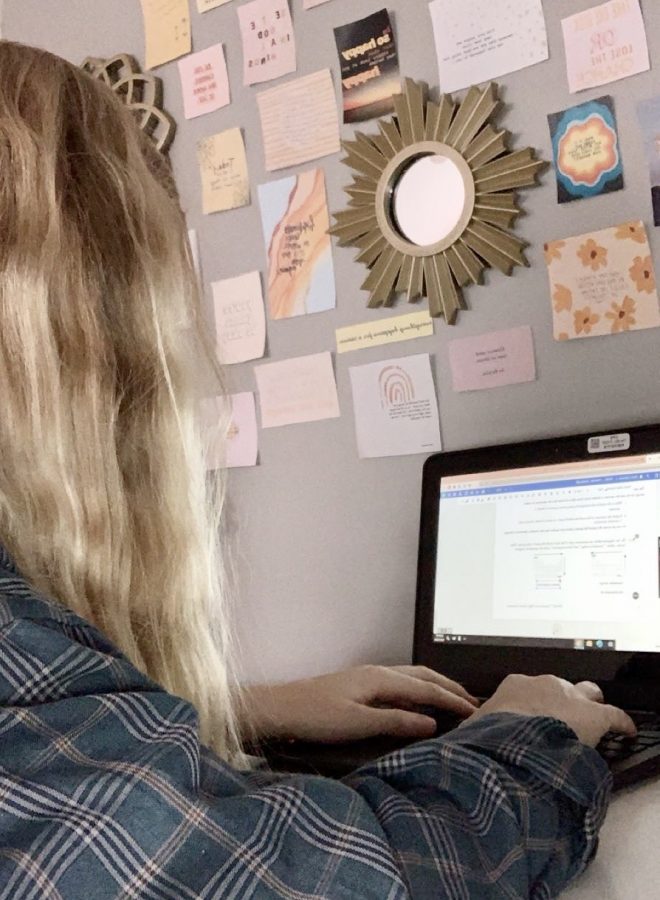The unseen struggles of online learning
The coronavirus has affected everyone in the world some way or another, but it has been especially difficult for students learning virtually.
The current WHHS schedule has students learning online Monday through Friday in a block schedule format. This is the best option for staying safe, however, the online aspect has taken a toll on many.
For some, it is the lack of social interaction. So many teens crave social interaction that they would normally get at school, but have not been able to experience recently. For me, at least, social interaction keeps me sane. It is difficult for those who do not play sports to keep social, and even sports bring up a greater risk of contracting the virus.
Calling or facetiming friends at lunch time or after school is a great way to stay social without putting yourself at risk. On weekends, seeing friends in a socially distant manner is also a solution, and a great way to keep in touch with others. Keeping social is essential to teen mental health, despite these rough times.
Many students are struggling to stay focused and learn the material at hand, and I don’t blame them. Ninety minute classes on a computer screen are not very entertaining, and it is easy to zone out and hard to stay focused, especially when you’re not in a typical classroom setting.
There are a lot of distractions at home, and there is nobody forcing students to pay attention, so some simply chose not to.
That being said, there is not much the teachers can do differently to keep their students attentive. The at home setting may have some benefits, but it is hard for teachers to know if they are effectively teaching their students.
One way teachers can help their students stay focused is to give them five minute breaks within the 90 minute block. This gives students time to go on their phone or get a snack, and the blocked out time will encourage them to come back to class with a more attentive mind.
Kahoots and online interactive games that have to do with the material are also a great way to keep students engaged. Seeing the interaction with the material is more reassuring that students are paying attention than hoping they are listening to a long lecture.
With no face to face communication, it is unclear to many teachers how much we, as students, are struggling to understand and keep up with the material. Help sessions are not as easily accessible, and asking a teacher to explain a concept one-on-one over a computer screen is not an attractive option during class.
When in a classroom setting, asking questions is much easier, and when the teacher can see exactly what you are struggling with, they can help you. Online, sometimes I feel the pressure to say I understand when I don’t because I do not want to waste time.
Lots of kids get anxious when they have to unmute themselves as well, I know I do, but it is difficult for teachers to know if the students are grasping the material without asking the students questions.
I think it would be helpful for teachers to find short videos to link on Schoology over the material that was just taught, so students have more resources to check that they know the material.
Breakout rooms are also an option, however, the effectiveness really depends on the students in the breakout room. I have been in some where everyone gets involved in the conversation, and I have also been in some where it is completely silent the whole time.
The workload has also been in issue for some students. It has been communicated to the teachers not to give us more than 60 minutes of homework each week, or 30 minutes if the Wednesday block is mandatory. Some have been within this margin, however, others have exceeded it. Of course, it depends on how long it takes the student, but some assignments go well over this limit.
Assignments pile up quickly, so if a few aren’t completed, a student might be behind for weeks. The motivation to get work done is not present in many students, and procrastination is a hard obstacle to overcome when stuck at home.
One way to combat this issue is to give students time during class to get started on their assignments. Many teachers end class early and tell students to use the rest of class time to work on their assignments, but many students just go on their phones for the rest of class.
Keeping us on the call and going through how to do the assignments, or even doing some with us is a lot more effective, and will help us keep up with our assignments. Not to mention, if teachers start the homework with us in class, they can count on us to pay attention. Students will not zone out if homework answers are being gone over.
The internet and technology is another issue. I have experienced my computer turn off in the middle of a Google Meet multiple times, and other times the laggy internet has just made it difficult. The internet is an unpredictable and uncontrollable factor that affects so many students.
It is vital for teachers to keep checking in with their students on if their internet has been stable at home, and how they are doing with the workload. Some teachers use a weekly Google form.
All of the struggles of online learning combined can make a very stressed teenager, so make sure to keep checking in on your friends and family members to see how they are doing with online school.
All views shared in the Opinions section of The Chatterbox belong to their respective authors, and may not represent the views of the publication as a whole.
Your donation will support the student journalists of Walnut Hills High School. Your contribution will allow us to purchase equipment, cover our annual website hosting, printing costs and offset competition and conferences fees for students.













